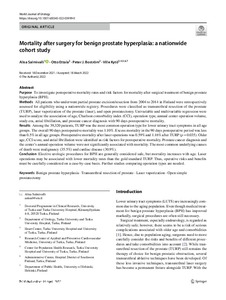Mortality after surgery for benign prostate hyperplasia: a nationwide cohort study
Salmivalli Alisa; Ettala Otto; Boström Peter J; Kytö Ville
https://urn.fi/URN:NBN:fi-fe2022081153682
Tiivistelmä
Purpose
To investigate postoperative mortality rates and risk factors for mortality after surgical treatment of benign prostate hyperplasia (BPH).
Methods
All patients who underwent partial prostate excision/resection from 2004 to 2014 in Finland were retrospectively assessed for eligibility using a nationwide registry. Procedures were classified as transurethral resection of the prostate (TURP), laser vaporization of the prostate (laser), and open prostatectomy. Univariable and multivariable regression were used to analyze the association of age, Charlson comorbidity index (CCI), operation type, annual center operation volume, study era, atrial fibrillation, and prostate cancer diagnosis with 90 days postoperative mortality.
Results
Among the 39,320 patients, TURP was the most common operation type for lower urinary tract symptoms in all age groups. The overall 90 days postoperative mortality was 1.10%. Excess mortality in the 90 days postoperative period was less than 0.5% in all age groups. Postoperative mortality after laser operations was 0.59% and 1.16% after TURP (p = 0.035). Older age, CCI score, and atrial fibrillation were identified as risk factors for postoperative mortality. Prostate cancer diagnosis and the center's annual operation volume were not significantly associated with mortality. The most common underlying causes of death were malignancy (35.5%) and cardiac disease (30.9%).
Conclusion
Elective urologic procedures for BPH are generally considered safe, but mortality increases with age. Laser operations may be associated with lower mortality rates than the gold standard TURP. Thus, operative risks and benefits must be carefully considered on a case-by-case basis. Further studies comparing operation types are needed.
Kokoelmat
- Rinnakkaistallenteet [27094]
